Pompeii. Household shrines to the domestic gods, VI.1.1 to VI.7.23.
For some of these the actual purpose is unknown.
The individual locations identified on each item may contain further photos and details, you can see these by looking at the pompeiiinpictures pages in question.
Back to household shrines list
Region VI
VI.1.1 Pompeii.
Sacrarium.

VI.1.1 Pompeii. December 2007. Looking towards north-east corner with two niches.
On the north wall was a niche that had been in the remains of a windowless sacrarium
On the east wall was another niche which was outside the sacrarium, at the end of a passage from the triclinium.

VI.1.1 Pompeii. May 2003. Arched niche on east wall. Photo courtesy of Nicolas Monteix.
Originally this niche was at the end of a passage from the triclinium.
The wall around the niche was painted with red stucco. Red, rose-like flowers were painted inside the niche.
See Boyce G. K., 1937. Corpus of the Lararia of Pompeii. Rome: MAAR 14. (p.43, no.132)
See Fröhlich, T., 1991. Lararien und Fassadenbilder in den Vesuvstädten. Mainz: von Zabern. (p.273, L55, Picture 37,1).

VI.1.1 Pompeii. Drawing by Mazois, 1824, of windowless sacrarium, looking north.
See Mazois, F.,
1824. Les Ruines de Pompei : Second
Partie. Paris: Firmin Didot. (p. 47 and pl. X, fig. 1).

VI.1.1 Pompeii. May 2003. Niche with vaulted ceiling, on north wall of room 11.
Originally this was at the east end of the north wall of a windowless sacrarium. Photo courtesy of Nicolas Monteix.

VI.1.1 Pompeii. December 2007. Niche with vaulted ceiling, on north wall.
Originally this was at the east end of the north wall of a windowless sacrarium.
The walls of the niche were coated with white stucco with floral ornaments.
The rear wall was outlined with red stripes and had a painting of a wreathed figure.
On the floor in front, but near the north wall, stood a masonry altar decorated with the figure of a pig which wore a garland on its head.
See Fiorelli G.,
1860. Pompeianarum antiquitatum historia,
Vol. 1: 1748 - 1818, Naples, ii, 36 (March 8 1787).
See Boyce G. K., 1937. Corpus of the Lararia of Pompeii. Rome:
MAAR 14. (p.43,
no.132, Pl.40, 3 & 4).
See Mazois, F., 1824. Les Ruines de Pompei : Second Partie. Paris: Firmin Didot. (p. 47 and pl. 10, 1 & 2).

VI.1.1 Pompeii. May 2003. Niche with vaulted ceiling, on north wall. Photo courtesy of Nicolas Monteix.

VI.1.1 Pompeii. 1824 drawing by Mazois of painting in the niche.
Windowless sacrarium, at east end of north wall.
Mazois described a figure reclining on a couch, with a green mantle wrapped around her legs.
In her left hand she held a cornucopia and in her right she held a kantharos.
A table, on which were a cup and a box, was in front of the couch.
Above was a heavy garland with fruit.
See Mazois, F., 1824. Les Ruines de Pompei : Second Partie. Paris: Firmin Didot. (p. 47 and pl. X, fig. 2).
VI.1.7/25 Pompeii.
Painting, (room h). (No photo).
According to Boyce –
PAH reports the discovery in the house of a shrine of which there is no trace in the remaining ruins and which is not described by Helbig:
“uno stanzolino
con un quadro con cornice di fabbrica, che esprime 4 figure dipinte con uno
serpe sotto, di tonica bianca ma tutto ordinario”.
See PAH, I, ii, p.23, 167, (Sep 2 – Oct 14, 1784).
See Boyce G. K., 1937. Corpus of the Lararia of Pompeii. Rome: MAAR 14, (p.43, no.133).
See Giacobello, F., 2008. Larari Pompeiani: Iconografia e culto dei Lari in ambito domestico. Milano: LED Edizioni, (p.170, no.47)
Niche, north wall of small room near kitchen, with arched niche. (No photo).
According to Boyce –
In a small room located near the kitchen, in the complex reached from the south-west corner of the atrium which is entered at No.25, in the north wall is an arched niche (h.0.48, w.0.36, d.0.16, height above the floor 1.60), its walls coated with a fine white stucco and decorated with coloured spots, some green, some red. The niche is set near the east end of the north wall, directly opposite the entrance door.
See Boyce 1937, (p.43, no.134)
See Giacobello, F., 2008. Larari Pompeiani: Iconografia e culto dei Lari in ambito domestico. Milano: LED Edizioni, (p.290, no.C10)
VI.1.10 Pompeii.
Painting and niche (?), south side of kitchen.

VI.1.10 Pompeii. December 2007. Doorway to room 11, kitchen and latrine. Looking towards south wall.

VI.1.10 Pompeii. December 2007. Room 11, east wall with latrine and hearth, and south-east corner of kitchen.
According to Boyce, the print in Piranesi showed the south wall of the kitchen covered with a lararium painting in two zones.
In the upper zone was the figure of the Genius, pouring a libation on an altar, to the right of him stood a small Camillus.
On each side of this central group was an indistinct figure.
Above this zone are two other indistinct figures.
In the lower zone were the two serpents confronted at an altar.
See Boyce G. K., 1937. Corpus of the Lararia of Pompeii. Rome: MAAR 14. (p.43, no.135)
According to Giacobello, in the south corner of the kitchen a lararium painting was found upon excavation, but in a bad condition.
It is no longer conserved but was drawn by Piranesi.
Nissen referred to the existence of a niche near the hearth, no longer visible by Boyce’s time.
See Giacobello,
F., 2008. Larari Pompeiani: Iconografia e culto dei Lari in ambito
domestico. Milano: LED
Edizioni, (p.171, no.48)
See Fröhlich, T., 1991. Lararien und Fassadenbilder in den Vesuvstädten. Mainz: von Zabern. (p.273, L56, picture 37,2)
According to Boyce, Nissen referred to a niche for the Lares in one of the rooms in the neighbourhood of the kitchen. Nissen, 410.
See Boyce G. K., 1937. Corpus of the Lararia of Pompeii. Rome: MAAR 14. (p.43, no.136).

VI.1.10 Pompeii. Pre-1804. Room 11, drawing by Piranesi, described as “Plan and elevation of the kitchen in the House of the Surgeon”.

VI.1.10 Pompeii. 1804. Room 11, south wall of kitchen, detail from drawing by Piranesi of altar and lararium paintings.
See Piranesi, F, 1804. Antiquités de la Grande Grèce : Tome I. Paris : Piranesi and Le Blanc. (Plate XX).
Niche in north wall of room on south side of entrance corridor.

VI.1.10 Pompeii. December 2007. Room 19, looking towards niche in north-west corner on north wall.
VI.1.14 Pompeii.
Arched niche in north wall.

VI.1.14, Pompeii. December 2018. Looking towards north wall with arched niche. Photo courtesy of Aude Durand.

VI.1.14 Pompeii. December 2018. Arched niche in north wall. Photo courtesy of Aude Durand.
According to Boyce –
the walls of the niche (h.0.60, w.0.40, d.0.25, height above the floor 1.10) were coated with red stucco.
See Boyce G. K.,
1937. Corpus of the Lararia of Pompeii.
Rome: MAAR 14. (p.42, no.137).
VI.2.1/31 Pompeii.
Niche in north wall of bar-room.

VI.2.1 Pompeii. May 2003. Looking towards north wall of bar-room. Photo courtesy of Nicolas Monteix.

VI.2.1 Pompeii. December 2018.
Detail of niche in north wall of bar-room. Photo courtesy of Aude Durand.
According to Boyce-
the large rectangular niche (h.0.65, w.0.50, d.0.18, height above the floor 1.45) had its inside walls painted green.
Fiorelli referred
to it as “la nicchia dei Penati”
See Boyce G. K., 1937. Corpus
of the Lararia of Pompeii. Rome:
MAAR 14. (p44, No.138).
VI.2.4 Pompeii.
Painting on east wall of atrium.

VI.2.4 Pompeii.
1852. Looking east across atrium showing east wall of ala (left of centre) and
lararium painting with single serpent below.
See Gell, W. and
Gandy, J., 1852. Pompeiana: Third
Edition. London: Bohn. (p. 124, pl.
28).

VI.2.4 Pompeii. March 2019. East wall of ala/atrium with site of
lararium painting.
Foto Annette Haug, ERC
Grant 681269 DÉCOR.

VI.2.4 Pompeii. 1852
painting, by Gell showing upper part of lararium.
According to Boyce,
on the surface of a walled-up door which formerly led from the north ala into
the triclinium, located on the north side of the tablinum, was a lararium
painting upon a red background.
In the centre was a
blazing tripod, to the right of which stood the Genius, holding a patera above
the flame.
To the left of the
tripod was the tibicen with his foot upon a scabellum (foot stool).
On each side stood a
Lar in blue tunic and red pallium and holding rhyton and patera.
Across the top were
garlands which hung down on either side.
On the lower part of
the wall, was a single serpent.
Four holes in the
wall below the painting indicate the position of a projecting ledge for
offerings or the images of the gods.
See Boyce G. K.,
1937. Corpus of the Lararia of Pompeii.
Rome:
MAAR 14. (p. 44, no. 139).
See Fröhlich, T.,
1991, Lararien und Fassadenbilder in den
Vesuvstädten. Mainz: von Zabern. (p.274, L57, Abb.3).
See Gell, W. and Gandy, J., 1852. Pompeiana: Third Edition. London: Bohn. (p. 126, pl. 31).
![VI.2.4 Pompeii. c.1819 sketch by W. Gell of lararium.
See Gell W & Gandy, J.P: Pompeii published 1819 [Dessins publiés dans l'ouvrage de Sir William Gell et John P. Gandy, Pompeiana: the topography, edifices and ornaments of Pompei, 1817-1819], pl. 5 verso.
See book in Bibliothèque de l'Institut National d'Histoire de l'Art [France], collections Jacques Doucet Gell Dessins 1817-1819
Use Etalab Open Licence ou Etalab Licence Ouverte](Pompeii%20Household%20Shrines%20p6_files/image031.jpg)
VI.2.4 Pompeii. c.1819
sketch by W. Gell of lararium.
See Gell W &
Gandy, J.P: Pompeii published 1819 [Dessins publiés dans l'ouvrage de Sir
William Gell et John P. Gandy, Pompeiana: the topography, edifices and
ornaments of Pompei, 1817-1819], pl. 5 verso.
See book in Bibliothèque de l'Institut National d'Histoire de l'Art
[France], collections Jacques Doucet Gell Dessins
1817-1819
Use Etalab Open Licence ou Etalab Licence Ouverte
Lararium or small niche on west wall of cubiculum.

VI.2.4 Pompeii. December 2017.
Lararium or small niche, on west wall of cubiculum in the south-west corner of small garden.
Foto Annette Haug, ERC Grant 681269 DÉCOR.
According to Scafati’s Guide. “On the right side of the wall is seen a lararium, or small niche.
Here was found a small idol of metal, a small vase of gold, a piece of money, also of gold, and twelve others of bronze of the Emperor Vespasian.
In the cubiculum to the left were found, eight small columns of bronze and remains of gilt wood which formed part of a bed.”
See Scafati, Guide to Pompeii Illustrated,
1900. p.105-106.
VI.2.6 Pompeii.
Niche in north wall of room at rear of oven. (No photo).

VI.2.6 Pompeii. December 2018.
Looking east towards oven, from entrance. Photo courtesy of Aude Durand.
According to Boyce –
in the north wall of the room behind the oven was a large rectangular niche (h.0.90, w.0.60, d.0.40, h. above floor 1.50).
See Boyce G. K., 1937.
Corpus of the Lararia of Pompeii. Rome: MAAR 14. (p.44, no.140)
VI.2.14 Pompeii.
Garden painting on east wall of garden area, no traces remain.

VI.2.14 Pompeii.
September 2005. East wall of garden area.
On the rear wall of
the small garden area was a garden painting.
See Jashemski, W.
F., 1993. The Gardens of Pompeii, Volume
II: Appendices. New York: Caratzas. (p.122).

VI.2.14 Pompeii.
1812 garden painting on east wall at the rear of garden.
Painting by
Francesco Morelli, 1812, long wall of the small atrium.
Now in Naples
Archaeological Museum. Inventory number ADS 130.
Photo © ICCD. https://www.catalogo.beniculturali.it
Utilizzabili alle
condizioni della licenza Attribuzione - Non commerciale - Condividi allo
stesso modo 2.5 Italia (CC BY-NC-SA 2.5 IT)

VI.2.14 Pompeii.
Garden painting on east wall at the rear of garden.
Old undated
photograph courtesy of the Society of Antiquaries, Fox Collection.
This incorporated a
lararium with the likenesses of Egyptian deities, Isis, Osiris and Harpocrates.
See Jashemski, W.
F., 1993. The Gardens of Pompeii, Volume
II: Appendices. New York: Caratzas. (p. 122).
According to Boyce,
on the east wall was a shrine for Egyptian deities, which had disappeared
before Helbig made his descriptions.
Helbig’s
descriptions were taken from the Pomp. Ant. Hist.
Below the lararium
niche was a brick altar standing on the floor of the room, coated with red
stucco and with a yellow candelabrum painted on it.
See Boyce G. K.,
1937. Corpus of the Lararia of Pompeii.
Rome:
MAAR 14. (p. 44, no. 141).
See Fröhlich, T., 1991, Lararien und Fassadenbilder in den Vesuvstädten. Mainz: von Zabern. (p.275, L58).
According to CTP –
The painting of
Isis, Osiris and Harpocrates was found in March 1811. See PAH, I, 3, (pp.52-54)
– 16th March. (p.239, Addenda).
See Van der Poel, H.
B., 1983. Corpus Topographicum Pompeianum, Part II. Austin: University
of Texas. (p.247).
VI.2.16/21 Pompeii.
Niche, south wall of peristyle.

VI.2.16 Pompeii. May 2011. Looking south across peristyle.

VI.2.16 Pompeii. September 2005. Niche in south wall of peristyle.
Niche on exterior street wall, on north side of entrance doorway.

VI.2.16 Pompeii. March 2009. Niche on exterior north side of entrance doorway.
VI.2.22/15 Pompeii.
Aedicula lararium on south wall of peristyle/garden area.

VI.2.22 Pompeii. May 2011. Looking south from north portico.
According to Boyce, standing in the centre of the south wall is a fine aedicula lararium (h.2.55).
Upon a rectangular base, painted red, a heavy projecting ledge adorned with triple bands of stucco ornament supports a platform (1.10 x 0.35, height above the floor 0.75), upon which rest the bases of two tall, fluted columns (h.1.30) with bases and capitals – all coated with white stucco.
The columns in turn support a pediment, the tympanum of which is surrounded by a double cornice of stucco relief.
The back wall within the aedicula is hollowed out to form a shallow semi-circular niche, and painted blue.
See Boyce G. K.,
1937. Corpus of the Lararia of Pompeii.
Rome: MAAR 14, (p.44, no.142, Pl.5,2)

VI.2.22/15 Pompeii. Pre-1937-39. Aedicula niche lararium.
Photo courtesy of American Academy in Rome, Photographic Archive. Warsher collection no. 1552.
VI.2.24 Pompeii.
Niche, west wall of garden area.

VI.2.24 Pompeii. May 2011. Arched niche in west wall of garden area, or oecus.

VI.2.24 Pompeii. Pre-1937-39. Arched niche in west wall of garden area, or oecus.
Photo courtesy of American Academy in Rome, Photographic Archive. Warsher collection no. 1574.

VI.2.24 Pompeii. December 2007. Arched niche in west wall of garden area or oecus, with remains of marble shelf.
According to Giacobello, this is at quite a considerable height from the floor.
The internal walls of the niche were plastered in white stucco.
The niche was visible from the vestibule at the entrance.
See Giacobello,
F., 2008. Larari Pompeiani: Iconografia e culto dei Lari in ambito domestico.
Milano: LED Edizioni, (p.269 no.V42)
VI.2.28
Pompeii.
Niche, south wall of oecus. (No photo).

VI.2.28 Pompeii. September 2005. Looking south-west towards rear of house and small garden area.
The remains of two cubicula can be seen on the left, and in the upper middle would have been the Oecus.
On the south wall of the oecus, the lararium niche can be made out, above a white shelf.
At the rear of the oecus, across the rear of the house, would have been the garden area.
According to Giacobello, in the south wall of the oecus was a square niche with the residue of white plaster and shelf in marble.
See Giacobello, F., 2008. Larari Pompeiani: Iconografia e culto dei Lari in ambito domestico. Milano: LED Edizioni. (p.290, no.C11)
According to Boyce, in the south wall of the oecus which opens off the garden is a rectangular niche.
The walls of the niche are coated with stucco and painted green.
The floor of the
niche is a thick slab of marble; the reports called it la nicchia per i
Penati.
See Boyce G. K.,
1937. Corpus of the Lararia of Pompeii.
Rome: MAAR 14. (p.44, no.143)
VI.2.29 Pompeii.
Niche in north wall of corridors 5/7. (No photo).

VI.2.29 Pompeii. September 2005. Looking west from entrance doorway, along corridors 5 and 7 to rear.
According to Fiorelli, there was a lararium in the long corridor.
See Pappalardo, U., 2001. La Descrizione di Pompei per Giuseppe Fiorelli (1875). Napoli: Massa Editore. (p.52)
According to Boyce, in the north wall of the corridor is a niche with peaked ceiling formed by two tiles set at an obtuse angle.
Fiorelli referred to it as larario.
See Boyce G. K., 1937. Corpus
of the Lararia of Pompeii. Rome:
MAAR 14. (p.44, no.144).
VI.2 (?) Mystery house, the location of which is very uncertain.
Painting of Lares in kitchen.
According to Boyce –
The house, the
location of which is very uncertain.
In the kitchen, there was discovered a painting of the Dei Lari, nella
stessa conformità che si sono trovati i altre simili cucine.
He quotes Helbig,
95, PAH I, iii, p. 41, 237 (Aug. 18, 1810)
See Boyce G. K., 1937. Corpus of the Lararia of Pompeii. Rome: MAAR 14. (p.44-45,
No.145).
VI.3.3/27/28 Pompeii.
Lararium painting on west wall of bakery – no traces remain.

VI.3.3 Pompeii.
December 2018.
Room 7, looking
south across site of household shrine towards oven. Photo courtesy of Aude
Durand.

VI.3.3
Pompeii. December 2018.
Room 7, west wall with site of household
shrine above cistern mouth/well head and a vessel for holding water on either
side.
Photo courtesy of Aude Durand.

VI.3.3 Pompeii.
Detail from Mazois sketch of lararium painting. In the middle of the lararium
is a painted round altar.
To the left of the
altar is the goddess Fornax (as identified by Mazois) in a long robe.
Fornax was the
goddess of bread and baking. On the left of the goddess is Lar.
In the right half,
which is obscured by the mill, was possibly Vesta with another Lar on the
outside.
In the lower zone
are two serpents approaching a round altar, one from each side.
See Fröhlich, T., 1991. Lararien und
Fassadenbilder in den Vesuvstädten. Mainz: von Zabern. (p.275, L59).
See Mazois, F., 1824. Les Ruines de
Pompei: Second Partie. Paris: Firmin Didot, Tav. XIX fig. 1.
VI.3.7 Pompeii.
Painting and niche, east wall of garden.

VI.3.7 Pompeii. December 2007. Niche and altar on east wall of garden area.
According to Boyce, the niche was undecorated, but the altar was coated with red stucco.
Behind the altar was a rectangle of white stucco, which served as a background for the Lararium painting.
See Boyce G. K., 1937. Corpus of the Lararia of Pompeii. Rome: MAAR 14. (p.45, and pl.12,2 and 4)
See Giacobello,
F., 2008. Larari Pompeiani: Iconografia e culto dei Lari in ambito
domestico. Milano: LED Edizioni, (p.172, no.49)

VI.3.7 Pompeii. Pre-1937-39. Niche and altar on east wall of garden area.
Photo courtesy of American Academy in Rome, Photographic Archive. Warsher collection no. 953.

VI.3.7 Pompeii. Mazois drew this picture of a painting, altar and a niche but did not identify their location.
See Mazois, F., 1824. Les Ruines de Pompei : Second Partie. Paris: Firmin Didot, p. 69, Pl. 24.2.
Boyce (Plate 12. 4) describes this "as it appeared shortly after discovery in 1810" From Mazois II pl. 24, 2.
According to Boyce, the niche was undecorated, but the altar was coated with red stucco.
Behind the altar was a rectangle of white stucco, which served as a background for the Lararium painting.
Boyce makes the comment that there is a remarkable similarity between this, as reproduced by Mazois, and his painting of the shrine in the Temple of Isis, without the niche, in Vol. IV, pl.11, 5 of the same work.
See Boyce G. K., 1937. Corpus of the Lararia of Pompeii. Rome: MAAR 14. (p.45, and pl.12,2 and 4)
See Giacobello, F., 2008. Larari Pompeiani: Iconografia e culto dei Lari in ambito domestico. Milano: LED Edizioni. (p.172, no.49).
VI.3.20 Pompeii.
Niche in west wall of rear room.

VI.3.20 Pompeii. May 2013. Looking into rear room in north-west corner of bar-room. Photo courtesy of Paula Lock.

VI.3.20 Pompeii. May 2003. Niche in west wall of rear room. Photo courtesy of Nicolas Monteix
In the west wall of the rear room is a rectangular niche (h.0.50, w. 0.38, d.025, h. above floor 1.15), its walls coated with red stucco.
See Boyce G. K., 1937. Corpus of the Lararia of Pompeii. Rome: MAAR 14, (p.45, no.147).

VI.3.20 Pompeii. December 2018.
Niche in west wall of rear room. Photo courtesy of Aude Durand.

VI.3.20 Pompeii. December 2018.
Detail of niche in west wall of rear room. Photo courtesy of Aude Durand.
VI.3.24 Pompeii.
Niche in north wall of shop-room.

VI.3.24 Pompeii. December 2018. Looking towards north wall with niche. Photo courtesy of Aude Durand.
According to Boyce –
In the north wall of the main room is a rectangular niche
(h.0.60, w.055, d.0.28, h. above the floor 1.50), its walls coated with white
stucco; it is called by Fiorelli la nicchia dei Penati.
See Boyce G. K., 1937. Corpus of the Lararia of Pompeii. Rome: MAAR 14, (p.45, no.148).

VI.3.24 Pompeii. December 2018. Niche in north wall. Photo courtesy of Aude Durand.

VI.3.24 Pompeii. December 2018. Detail of niche in north wall. Photo courtesy of Aude Durand.
VI.4.3/4 Pompeii.
Niche in west wall, no traces remain.

VI.4.3 Pompeii. December 2004. Looking west from entrance, across counter and towards linking doorway to VI.4.4.
According to Boyce, in the west wall of the room with the counter were the ruins of a niche.
Its walls were coated with white stucco and decorated with coloured spots.
Its floor was a projecting tile.
See Boyce G. K., 1937. Corpus of the Lararia of Pompeii. Rome: MAAR 14. (p. 45, no. 150).
According to Garcia y Garcia due to the bombing, the niche to the west of the thermopolium has sadly disappeared.
Also lost was the recess, perhaps for a bed in the south-east of the small rear room.
See Garcia y
Garcia, L., 2006. Danni di guerra a Pompei. Rome: L’Erma di Bretschneider. (p. 75).
VI.4.4 Pompeii.
Painted lararium on north wall.

VI.4.4 Pompeii. October 2020. Looking west across bar room. Photo courtesy of Klaus Heese.

According to Boyce, above a strip of ordinary red stucco on the wall was a rectangular panel of white stucco, marked off with red stripes.
Above that was a smaller rectangle which was enclosed within the aedicula façade.
The painting within the aedicula showed the figure of the Genius standing on the right of a yellow altar.
Behind the altar stood the tibicen and towards the same altar, coiled the two serpents, one from each side.
On each side of this group stood a Lar, clad in yellow tunic, green girdle and red pallium.
These figures are standing higher than the other figures.
The lower rectangle probably also contained painted figures, but none were visible, and had not been described in previous reports.
See Boyce G. K., 1937. Corpus of the Lararia of Pompeii. Rome: MAAR 14. (p. 46, no. 151)

VI.4.4 Pompeii but
shown as VI.4.7 on photo. Pre-1937-39. Lararium shrine on north wall.
Photo courtesy of
American Academy in Rome, Photographic Archive. Warsher collection no. 018.
See Boyce G. K.,
1937. Corpus of the Lararia of Pompeii.
Rome:
MAAR 14. (p. 46, no. 151).
See Fröhlich, T.,
1991, Lararien und Fassadenbilder in den
Vesuvstädten. Mainz: von Zabern. (p.275, L60).
VI.5.3 Pompeii.
Niche, west wall room 3 (PPM), (our room 20).

VI.5.3 Pompeii. December 2007. Doorway to room 20, on south side of entrance corridor.
According to Helbig, paintings found in this room were Theseus & Ariadne (1212),
Apollo & Artemis (200), Floating girls (1903, 17, 33, 49)
See Helbig, W., 1868. Wandgemälde der vom Vesuv verschütteten Städte Campaniens. Leipzig: Breitkopf und Härtel. (1212, 200, etc)

VI.5.3 Pompeii. December 2007. Room 20, niche in west wall.
According to Boyce, in the room opening off the south-west corner of the atrium, in the west wall opposite the entrance door, is an arched niche.
This is set high up in the wall.
Its interior walls were painted with green plants on a white background.
The niche is made to stand out from the decoration of the walls of the room, for it is set across the line which divides the lower panels, which are alternating red and yellow, from the upper register, which is white.
See Boyce G. K., 1937. Corpus
of the Lararia of Pompeii. Rome:
MAAR 14, p. 46, no.152.
See Giacobello,
F., 2008. Larari Pompeiani: Iconografia e culto dei Lari in ambito
domestico. Milano: LED Edizioni, (p.290, no.C12)
Another niche.

VI.5.3 Pompeii. December 2007. Room 3 at front, the north ala.
According to Garcia y Garcia, in 1943 a bomb fell near the atrium causing the total destruction of the north ala, and of the three adjacent rooms.
The north perimeter wall that separated this from the other dependent area at VI.5.2 was destroyed, as well as an interesting 4th style architectural decoration. In 1976 there was a restoration that was neither precise nor total.
See Garcia y
Garcia, L., 2006. Danni di guerra a Pompei. Rome: L’Erma di Bretschneider. (p.75).

VI.5.3 Pompeii. December 2007. Niche in room 3, the north ala.
V.5.5 Pompeii.
Lararium in large room opening off the east side of the peristyle. (No
photo).
According to Boyce –
In the large room opening off the east side of the peristyle was “un larario”.
He gave the reference Ann. Inst., x, 1838, 186.
See Boyce G. K., 1937. Corpus of the Lararia of Pompeii. Rome: MAAR 14, (p.46, no.153)
Another niche.

VI.5.5 Pompeii. September 2005. East wall of atrium with niche, looking towards peristyle.

VI.5.5 Pompeii. December 2018. Detail of niche in east wall of atrium. Photo courtesy of Aude Durand.
VI.5.14 Pompeii.
Aedicula lararium against west wall of garden area.

VI.5.14 Pompeii. December 2005.
According to Jashemski, standing against the west wall at the end of the north portico was an aedicula lararium.
See Jashemski, W. F., 1993. The Gardens of Pompeii, Volume II: Appendices. New York: Caratzas. (p.126).

VI.5.14 Pompeii. 1930s photo of lararium by Tatiana Warscher.
According to Boyce, it had a solid base with two heavy walls forming a rectangular niche, surmounted by a gable roof with a simple pediment.
The walls inside were covered with unpainted white stucco.
In the floor was embedded a square block of marble, in which was cut a rectangular hole.
It was as if this was meant to hold the pivot upon which turned a door to close the shrine.
See Boyce G. K., 1937. Corpus of the Lararia of Pompeii. Rome: MAAR 14. (p.46, no.154, and Pl.34,2)
See Giacobello,
F., 2008. Larari Pompeiani: Iconografia e
culto dei Lari in ambito domestico. Milano: LED Edizioni. (p.269, no.V43)
VI.5.16 Pompeii.
Niche, east wall in cubiculum.
Giacobello quoted Boyce but see VI.5.17 below.
See Giacobello, F., 2008. Larari Pompeiani: Iconografia e culto dei Lari in ambito domestico. Milano: LED Edizioni, (p.291, no.C13)
VI.5.17 Pompeii.
Arched niche in east wall of a rear room.

VI.5.17 Pompeii. March 2009. Room behind atrium area, east wall with niche and window to atrium.

VI.5.17 Pompeii. March 2009. Niche in east wall of room on west side of atrium area.
According to Boyce, in the east wall of a rear room is an arched niche (h.0.45, w.0.35, d.0.22, h. above floor 1.45).
The walls of the niche were coated with at least three successive layers of stucco.
The middle layer was red.
See Boyce G. K., 1937.
Corpus of the Lararia of Pompeii. Rome: MAAR 14. (p.46, no.155)
VI.6.1 Pompeii.
Painting and niche, north wall of kitchen.

VI.6.1 Pompeii. December 2007. Room 16, niche on north wall of kitchen area in north-west corner of peristyle.

VI.6.1 Pompeii. Room 16, kitchen area in north-west corner of peristyle.
Sketch by Mazois of the painted lararium that was found on the north wall, but no longer visible.
See Mazois, F., 1824. Les Ruines de Pompei: Second Partie. Paris: Firmin Didot. (p. 85-7, Pl. XLV, 2).
A genius stood to the right of a blazing round altar. A very small tibicen was to the left of the altar.
A tall wreathed Lar, dressed in blue tunic, red Pallium and high boots stood on each side.
Each Lar was pouring wine from a rhyton to a situla, Garlands and bushes were also in the scene.
In the lower part two huge serpents, in a background of plants, confronted a round altar which had offerings.
See Boyce G. K., 1937. Corpus
of the Lararia of Pompeii. Rome:
MAAR 14. (p.46, no.156, Plate 18,1).
See Fröhlich, T., 1991, Lararien und
Fassadenbilder in den Vesuvstädten. Mainz: von Zabern.
(p.276, L61, taf. 35,1).
See Giacobello, F., 2008. Larari Pompeiani: Iconografia e culto dei Lari in ambito domestico. Milano: LED Edizioni. (p. 172-3, 50).
VI.6.2 Pompeii.
Niche on west wall of shop-room.


VI.6.2 Pompeii. December 2018. Niche in west wall of shop. Photo courtesy of Aude Durand.
According to Boyce, on the west wall was an arched niche, called by Fiorelli la nicchia dei Penati.
See Boyce G. K., 1937. Corpus
of the Lararia of Pompeii. Rome:
MAAR 14. (p. 47, no. 157).
See Pappalardo, U., 2001. La Descrizione di Pompei per Giuseppe Fiorelli (1875). Napoli: Massa Editore. (p. 55).

VI.6.2 Pompeii. December 2018. Detail of niche in west wall of shop. Photo courtesy of Aude Durand.
VI.6.20 Pompeii.
Painting of a serpent on west wall of shop-room, no traces remain. (No photo).

VI.6.20 Pompeii. May 2005. Looking east at
entrance doorway of corner shop.
According to Stefani, this was a large corner
sales shop for the bakery at its rear.
On the west wall was a lararium painting with
serpent, on the facing wall was a supposed “cross” in stucco.
See Stefani, G. (2005): Pompei. Un Panificio: in Cibi e Sapori a
Pompei e dintorni, (p.139).
According to Boyce –
VI.6.17 and VI.6.20/21. Pistrinum with
taberna.
On the wall of the room entered at No.17 was
painted a serpent, and beneath it a tile projected for offerings.
He quotes the references – Fiorelli,
Descrizione, 105, and Breton, p.248 (see below).
See Boyce G. K., 1937. Corpus of the Lararia of Pompeii. Rome: MAAR 14, (p.47, no.158 A).
According to Boyce –
“…..nel panificio…..un dipinto larario
scomparso”, according to Fiorelli; the print in
Gell-Gandy shows a single serpent painted on the front side of the oven.
He quotes – Fiorelli,
Descrizione, 105, Gell-Gandy, Pompeiana (1852), pl.38
See Boyce G. K., 1937. Corpus of the Lararia of Pompeii. Rome: MAAR 14, (p.47, no.159 B).
According to Breton –
La pièce 9 a offert une particularité
que Mazois n’a pas manqué de signaler : sur la paroi intérieure du trumeau
existait une peinture représentant un serpent, symbole d’une divinité custode,
ou gardienne de la maison, et a cote était scellée dans le mur une brique en
saillie, qui servaint a porter la lampe
qui brulait continuellement en son honneur.
En face de cette représentation
toute païenne, et bien en évidence, était une croix latine en bas-relief, ou du
moins un objet qui en a toute la forme ; il serait bien singulier qu’il fût
permis d’y voir un symbole de la nouvelle religion du Christ.
See Breton, E. Pompeia, 1870, (p. 248-9).
(translation: “No. 9 (VI.6.17/18) had a
peculiarity that Mazois did not fail to point out: on the inside wall of the
room there was a painting showing a serpent, symbol of a deity, or guardian of
the house, and next to it was a projecting tile/brick in the wall, which served
to carry the lamp that burned continuously in his honour.
In front of this pagan representation, and
prominently displayed, was a Latin cross in bas-relief, or at least an object
which had all the form of one; it would be very singular if it were allowed to
be seen as a symbol of the new religion of Christ.”
(on his plan on p.248, he allocates this
lararium painting to No.9, (VI.6.17/18) whereas Stefani/Della Corte state it
was in No.10, (VI.6.20), see below.
VI.7.3 Pompeii.
North wall of atrium.

VI.7.3 Pompeii. W 1276. North wall of atrium with niche.
Photo by Tatiana
Warscher. Photo © Deutsches Archäologisches Institut, Abteilung Rom, Arkiv.

VI.7.3 Pompeii. March 2009. Room 1, niche on north wall of atrium.
According to Boyce, this was a carefully executed arched niche.
Below it was a heavy cornice adorned with a frieze of polychrome stucco work projecting from the wall.
The niche itself was originally framed by an aedicula façade, of which only the half-columns at the sides remained.
A stucco cornice running around the curve of the arch was also visible to Boyce.
See Boyce G. K., 1937. Corpus of the Lararia of Pompeii. Rome: MAAR 14. (p.47, no.160, and Pl.6,3)
Described as a pseudo-aedicula lararium, north wall in atrium.
See Giacobello,
F., 2008. Larari Pompeiani: Iconografia e culto dei Lari in ambito
domestico. Milano: LED Edizioni, (p.241, no.A17)
VI.7.5 Pompeii.
Niche in north wall of
shop-room.

VI.7.5 Pompeii, on right. December 2018.
Looking north to doorway, with steps to upper floor at VI.7.4, on left. Photo courtesy of Aude Durand.

VI.7.5 Pompeii. December 2018. Niche in north wall of shop. Photo courtesy of Aude Durand.
According to Boyce, in the north wall was a trapezoidal niche called by Fiorelli “la nicchia dei Penati”.
See Boyce G. K., 1937. Corpus of the Lararia of Pompeii. Rome: MAAR 14. (p. 47, no. 161).

VI.7.5 Pompeii. December 2018. Detail of niche in north wall of shop. Photo courtesy of Aude Durand.
VI.7.6 Pompeii.
Aedicula lararium, north-east corner of peristyle.

VI.7.6 Pompeii. September 2004. Room 6, garden with lararium.

VI.7.6 Pompeii. 1930s photo by Tatiana Warscher. Room 6, garden lararium.

VI.7.6 Pompeii.
March 2009. Aedicula lararium.
See Boyce G. K., 1937. Corpus of the Lararia of Pompeii. Rome: MAAR 14. (p.47, no.162 and Pl.30,1)
See Fröhlich, T.,
1991. Lararien und Fassadenbilder in den
Vesuvstädten. Mainz: von
Zabern. (p.276, L.62)
See Giacobello,
F., 2008. Larari Pompeiani: Iconografia e
culto dei Lari in ambito domestico. Milano: LED Edizioni. (p.269 no.V44)
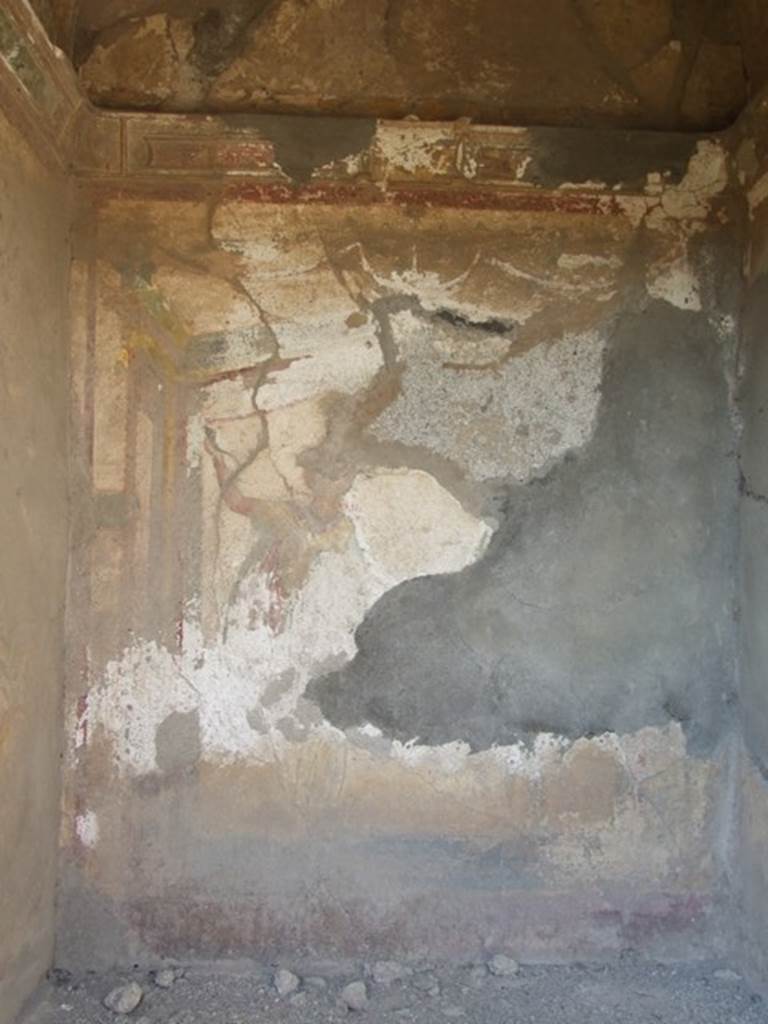
VI.7.6 Pompeii. March 2009. Rear wall of lararium, with remains of a figure of a Lar.

VI.7.6 Pompeii. March 2009. Detail of painting of a Lar.

VI.7.6 Pompeii. March 2009. West wall, painting of coils of serpent and remains of plants.
According to Boyce, on each of the side walls was a painting of a serpent, coiling towards an altar with two eggs and a pine cone on it.
See Boyce G. K., 1937. Corpus of the Lararia of Pompeii. Rome: MAAR 14. (p. 47, no. 162 and Pl. 30,1)
VI.7.7 Pompeii.
Lararium painting on north wall of kitchen, no traces remain.

VI.7.7
Pompeii. December 2018.
Looking north-west towards kitchen area at
rear of house, photo taken from VI.7.11. Photo courtesy of Aude Durand.

VI.7.7 Pompeii. December
2005. Kitchen, with bench and hearth against the west wall.
According to Boyce,
on the north wall of the kitchen was a lararium painting.
Only a fragment was
preserved, painted on a white background.
In the centre was
the Genius with a cornucopia and patera standing before a burning altar.
Behind him was a
camillus, above and behind the altar was the figure of the tibicen.
On either side of
this group stood the Lares in yellow tunic and green pallium.
Beyond the Lar on
the left was a small popa pushing a hog towards the right.
The corresponding
figure on the right of the right Lar was missing, as was the whole outer
section of the plaster on this side.
In the lower zone
was the customary altar with the two serpents.
See Boyce G. K.,
1937. Corpus of the Lararia of Pompeii.
Rome: MAAR 14. (p.47, no.163)
Boyce added a note
that said Helbig (58) wrongly assigned this shrine to VI.7.9.
See Helbig, W., 1868. Wandgemälde der
vom Vesuv verschütteten Städte Campaniens. Leipzig: Breitkopf und Härtel. (58).

VI.7.7 Pompeii.
Pre-1937-39.
Kitchen, with bench
and oven against the west wall, and remains of lararium painting on north wall.
Photo courtesy of
American Academy in Rome, Photographic Archive. Warsher collection no. 1589.
VI.7.8/12 Pompeii.
Niche on west wall with painted mask.

VI.7.9 Pompeii. May 2005. West wall of south ala, with niche with small painting of the head of the Gorgon.
According to Frohlich and Giacobello, on the west wall of the atrium, was a niche with a painted mask on a white background.
A painted lararium was also documented in this house but of this there is no trace, according to them.
See Fröhlich, T., 1991. Lararien und
Fassadenbilder in den Vesuvstädten. Mainz: von Zabern. (p.277, L63, Picture 34,1)
See Giacobello, F., 2008. Larari Pompeiani: Iconografia e culto dei Lari in ambito domestico. Milano: LED Edizioni. (p.242, no A18)
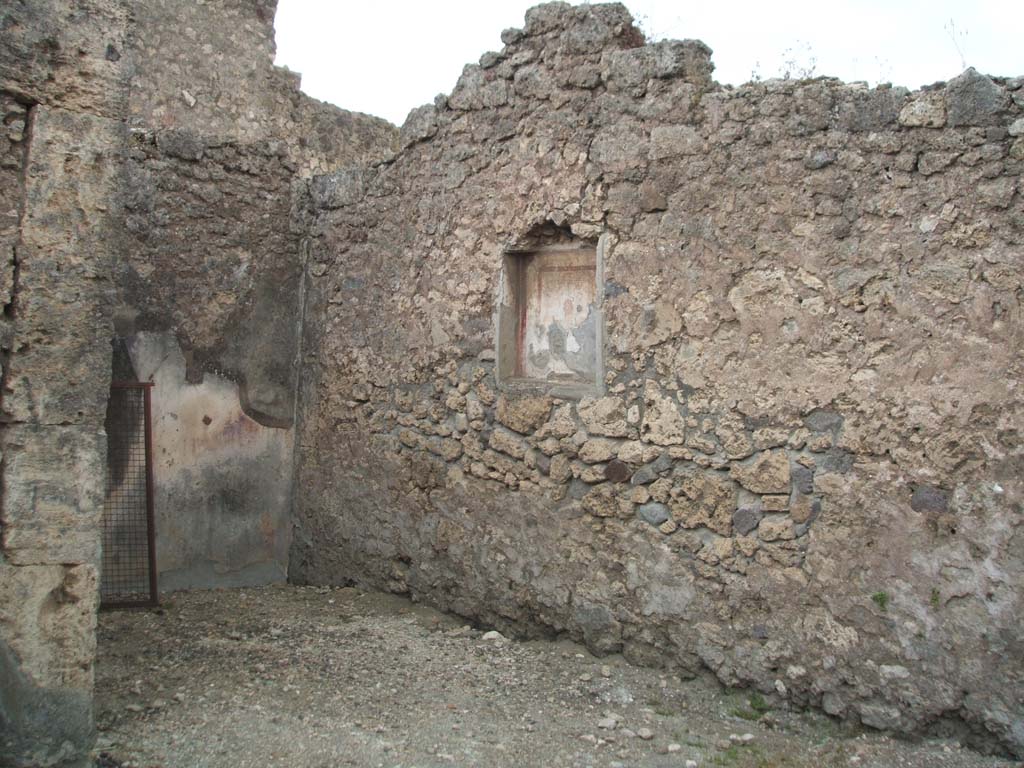
VI.7.9 Pompeii. December 2018.
West wall in south ala, showing niche with painted head of the Gorgon. Photo courtesy of Aude Durand.
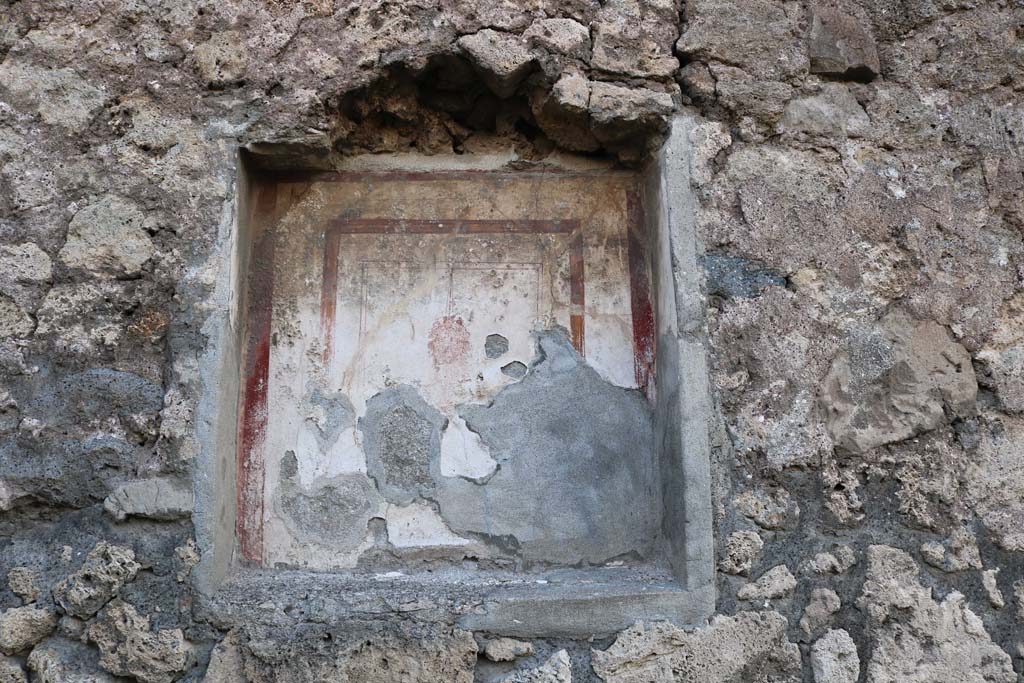
VI.7.9/10
Pompeii. W.1298. Painting in niche.
Photo by Tatiana
Warscher. Photo © Deutsches Archäologisches Institut, Abteilung Rom, Arkiv.
Painting, north wall of kitchen (?).

VI.7.11 Pompeii. December 2005. Doorway to room on west side of atrium, kitchen with hearth and water cistern.
According to Sogliano, in the kitchen was a painted lararium of an altar and a serpent nearby.
See Sogliano, A., 1879. Le pitture murali campane scoverte negli anni 1867-79. Napoli: (p.17, no.48).
According to Giacobello, the painting would have been on the north wall of the kitchen, but had already been damaged by the time of Boyce.
See Giacobello, F., 2008. Larari Pompeiani: Iconografia e culto dei Lari in ambito domestico. Milano: LED Edizioni, (p.174, no.51)
According to Boyce, Helbig wrongly assigned the shrine from VI.7.7, to VI.7.9 (see VI.7.7)
See Boyce G. K., 1937. Corpus
of the Lararia of Pompeii. Rome:
MAAR 14. (p.47, no.163, note 1)
VI.7.13
Pompeii.
Painting on wall of shop, no trace remains, (but niche on south wall).
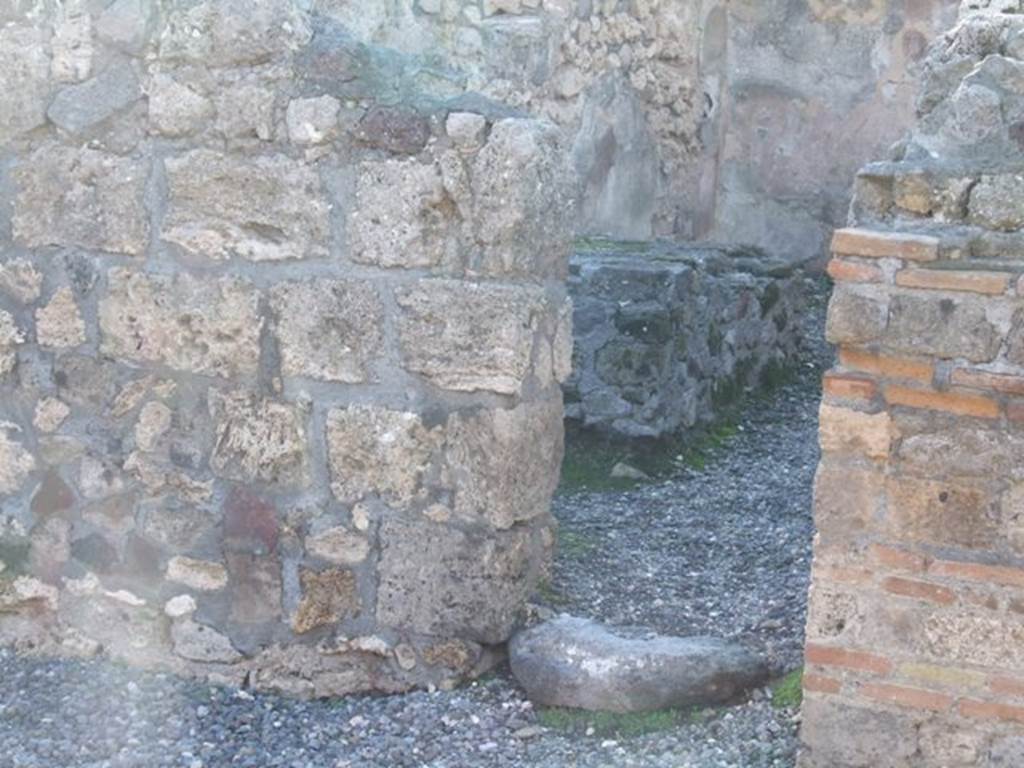
VI.7.13 Pompeii, on left and VI.7.14, on right. December 2018.
Looking south-west towards entrances on Via di Mercurio. Photo courtesy of Aude Durand.
According to Boyce –
“Taberna.
On one wall there is a painting of two serpents confronted at an altar
furnished with offerings”.
He quotes
references – Sogliano, 50; Fiorelli, Descrizione, 110; Niccolini, ii, Desc. Gen.,
31.
See Boyce G. K., 1937. Corpus of the Lararia of Pompeii. Rome: MAAR 14, (p.48, no.164).
See Sogliano,
A., 1879. Le pitture murali campane
scoverte negli anni 1867-79. Napoli:
(p.17, no.50, “nearly destroyed”)
According to Fiorelli - on one of the walls
of this shop there was a painted lararium.
Nothing appears to remain now.
Fiorelli reported that only the serpents at
the sides of the altar remained.
See Pappalardo, U., 2001. La Descrizione di Pompei per Giuseppe Fiorelli (1875). Napoli: Massa Editore. (p.58)
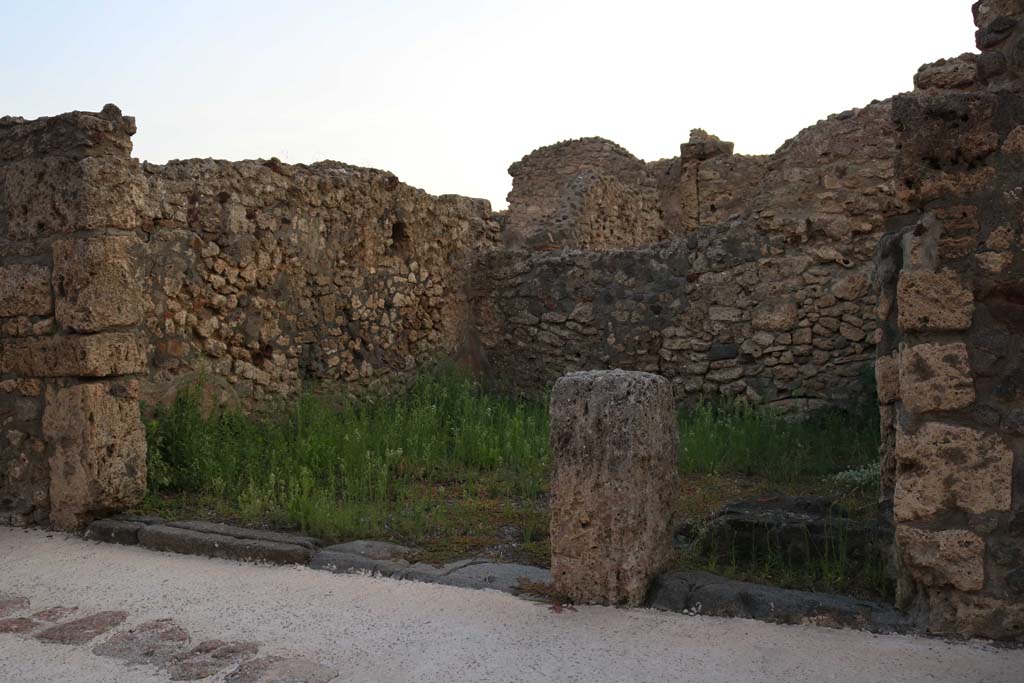
VI.7.13 Pompeii, December 2018. Recess/niche in south wall of shop. Photo courtesy of Aude Durand.
VI.7.15 Pompeii.
Lararium painting on west wall of kitchen, no traces remain.

VI.7.15 Pompeii.
December 2007. On the left would have been an area with steps to the upper
floor, and a window overlooking the yard.
This may have been
where Fiorelli located the lararium.
In his description
he said
“…..una gradinata per le località sovrastanti, un piccolo
recesso con cisterna, e col dipinto del Genio che sacrifice ed il serpe che si
avvicina al frutto del pino, un’area piu spaziosa con focolare......”
See Pappalardo, U., 2001. La
Descrizione di Pompei per Giuseppe Fiorelli (1875). Napoli: Massa Editore. (p.58).
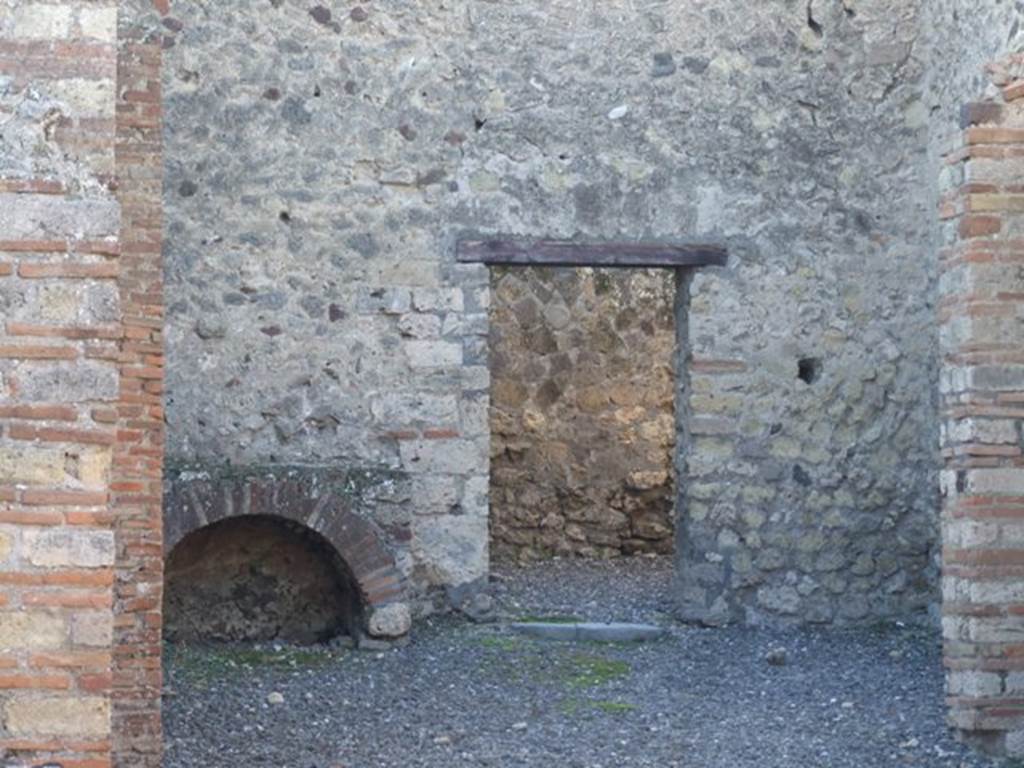
VI.7.15 Pompeii.
December 2007. Hearth in kitchen area against west wall.
According to Boyce,
on the west wall of the kitchen there was a lararium painting on a white
background.
A serpent glides
through plants towards an altar furnished with an egg and pine cone.
Below the painted
altar, a piece of tile projected from the wall, to serve for lamp or offerings.
To the right of the
same altar, stood the Genius, crowned, wearing high boots and a toga with a
fold drawn over his head.
See Boyce G. K.,
1937. Corpus of the Lararia of Pompeii. Rome:
MAAR 14. (p.48, no.165)
He also gave Helbig
as a reference:
See Helbig, W., 1868. Wandgemälde der
vom Vesuv verschütteten Städte Campaniens. Leipzig: Breitkopf und Härtel.
(32).
VI.7.20-22 Pompeii.
Aedicula lararium, west wall of
garden area.
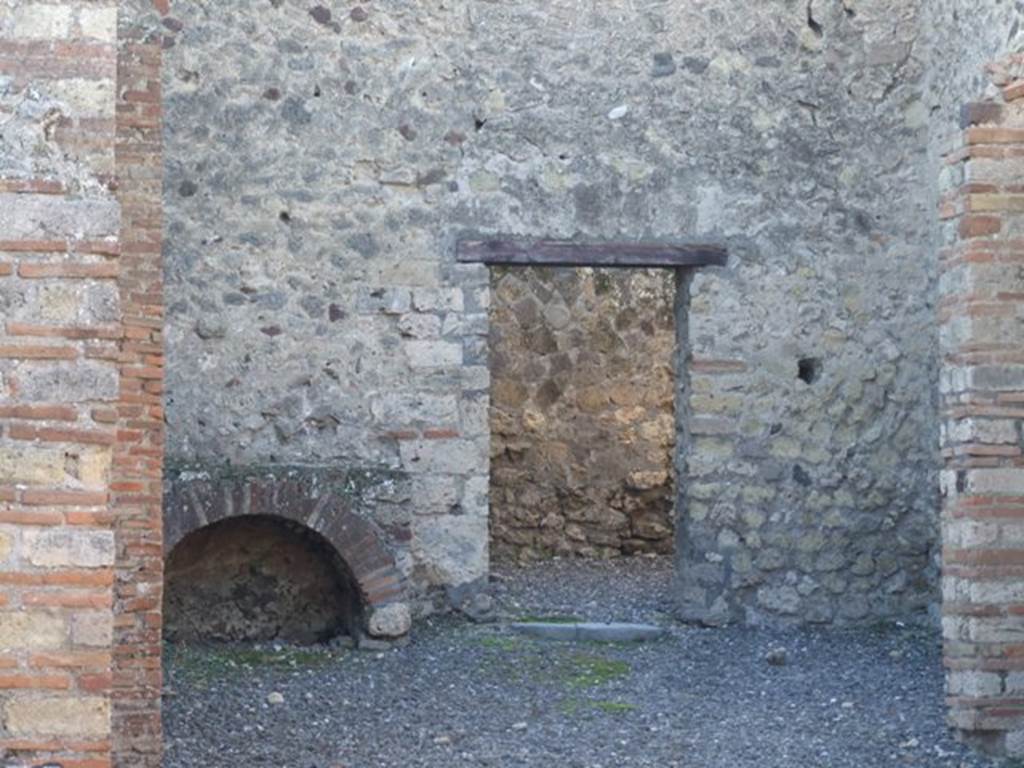
VI.7.20 Pompeii. October 2022.
Looking west to altar in peristyle. Photo courtesy of Klaus Heese.
According to Boyce –
Against the west wall of the pseudo-peristyle stands a huge aedicula.
See Boyce G. K.,
1937. Corpus of the Lararia of Pompeii.
Rome: MAAR 14, (p.48, no.166).
See Giacobello, F., 2008. Larari Pompeiani: Iconografia e culto dei Lari in ambito domestico. Milano: LED Edizioni, (p.270 no.V45)
VI.7.23 Pompeii.
Painting and niche, north wall of kitchen.
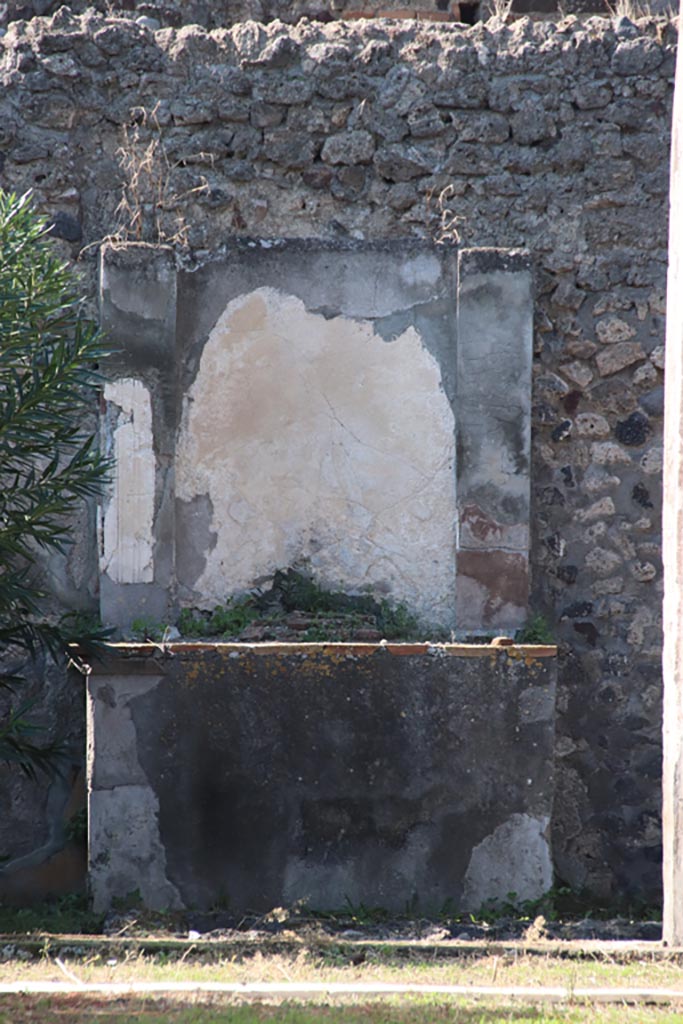
VI.7.23 Pompeii. July 2021. Looking
towards east end of kitchen with lararium niche and altar. Photo
courtesy of Johannes Eber.
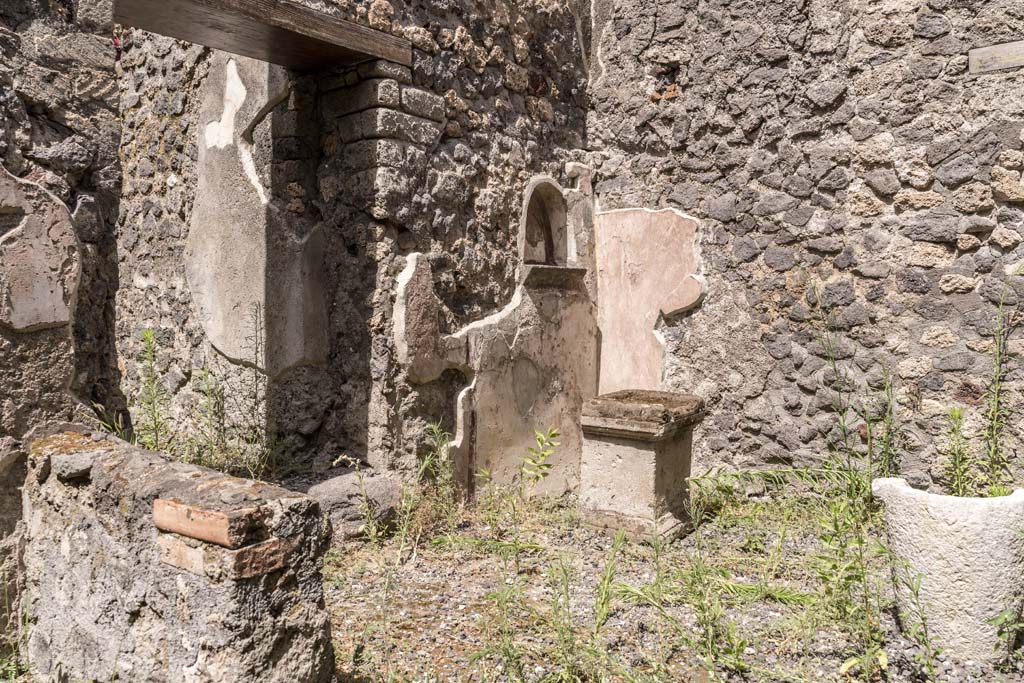
VI.7.23 Pompeii. July 2021. Lararium niche and altar in kitchen area. Photo courtesy of Johannes Eber.
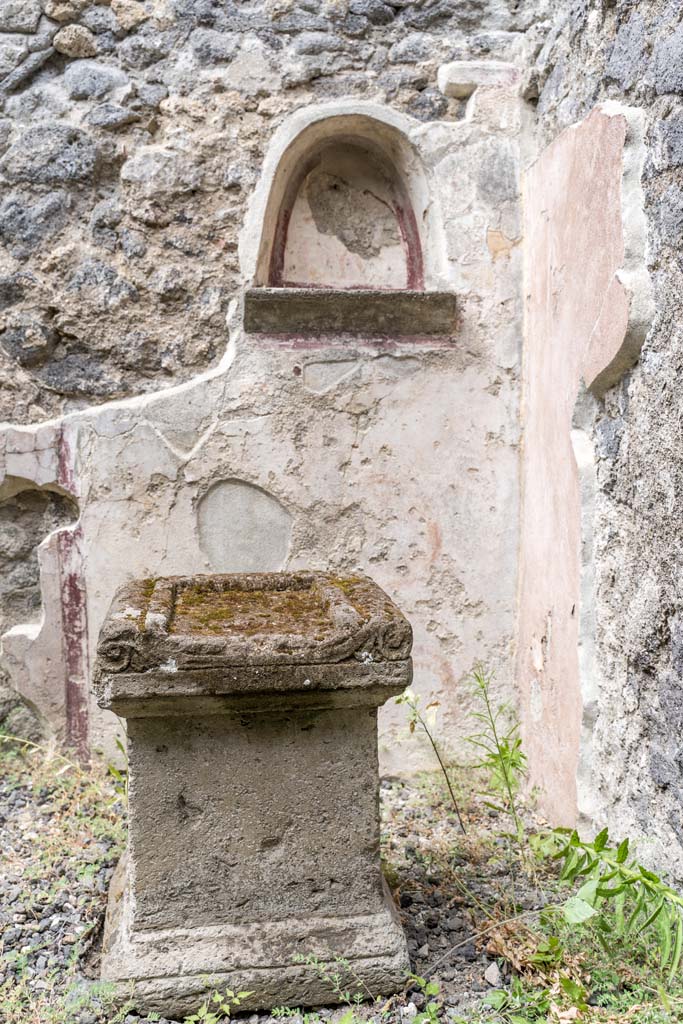
VI.7.23 Pompeii. Pre-1937-39. Kitchen, north wall with niche and painting of serpent.
Photo courtesy of American Academy in Rome, Photographic Archive. Warsher collection no. 957.
According to Boyce –
In the north wall near the north-east corner is an arched niche (h.0.42, w.0.45, d.0.15, height above floor 1.20).
Its inside walls were coated with white stucco, the corners outlined with broad red stripes.
Beneath it the floor projects 0.10 from the surface of the wall.
On the back wall of the niche is painted the figure of the Genius, holding with his right hand a patera above a flaming altar.
The wall around the niche is covered with a panel (h.1.70, w.1.10) of the same white stucco, bordered in red, and on each side of the niche is painted a Lar in yellow tunic and red pallium and holding rhyton and situla.
Below the niche a yellow serpent with red crest and beard coils towards a golden cylindrical altar adorned with a gorgoneion and having a fire on the top. Before the painted altar one of tufa (0.48 x 0.38, h.0.60) stands on the floor.
See Boyce G. K., 1937. Corpus of the Lararia of Pompeii. Rome: MAAR 14, (p.48, no.167).
See Fröhlich, T., 1991. Lararien und Fassadenbilder in den
Vesuvstädten. Mainz: von Zabern. (p.277, L64, taf.34,2).
See Giacobello, F., 2008. Larari Pompeiani: Iconografia e culto dei Lari in ambito domestico. Milano: LED Edizioni, (p.174, no.52).
Arched niche and two square recesses on north wall of garden area, behind site of summer triclinium.
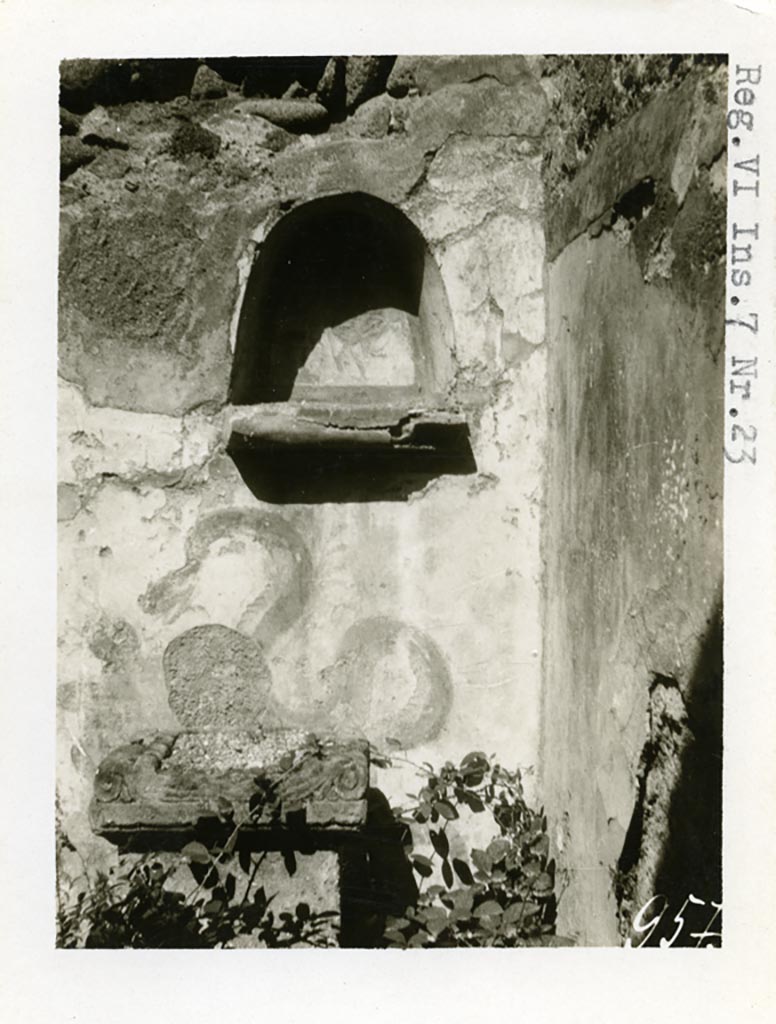
VI.7.23 Pompeii. October 2014. Looking north to niches on wall behind the site of the summer triclinium.
Foto Annette
Haug, ERC Grant 681269 DÉCOR.
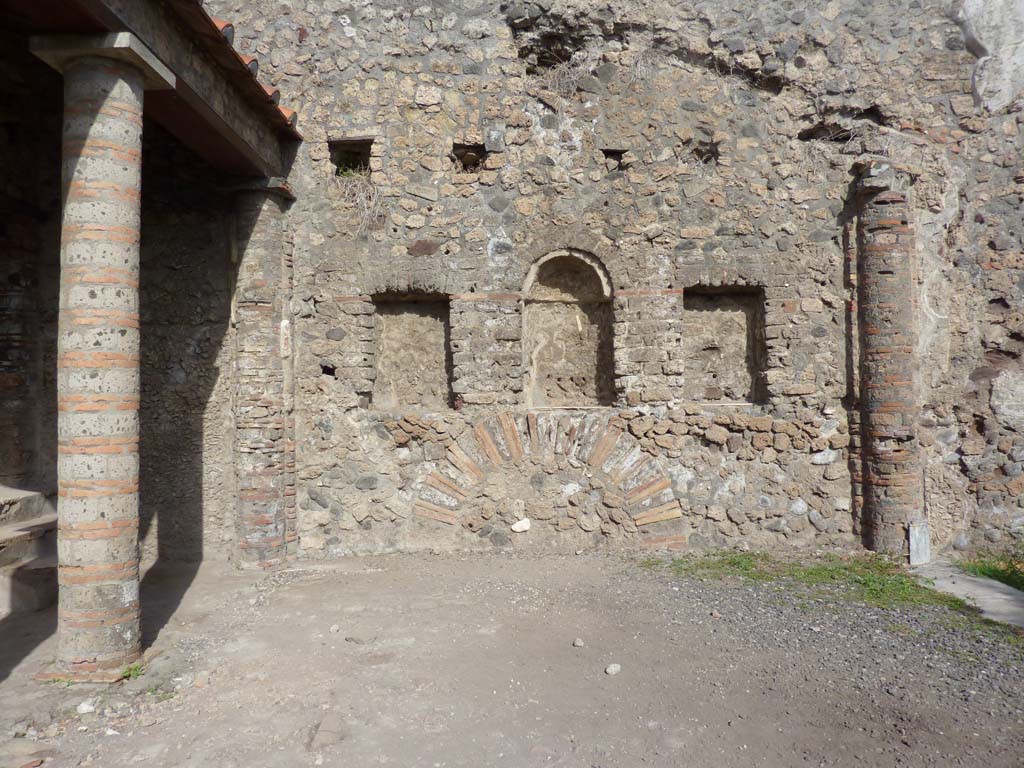
VI.7.23 Pompeii. December 2006. Central niche on the north wall behind the summer triclinium.
Back to household shrines list